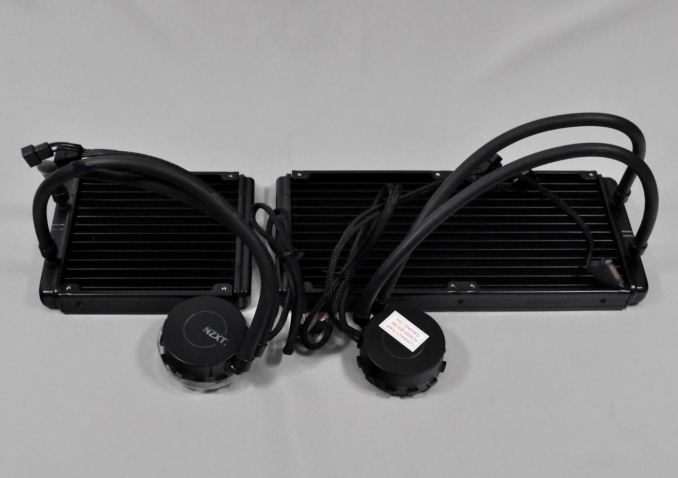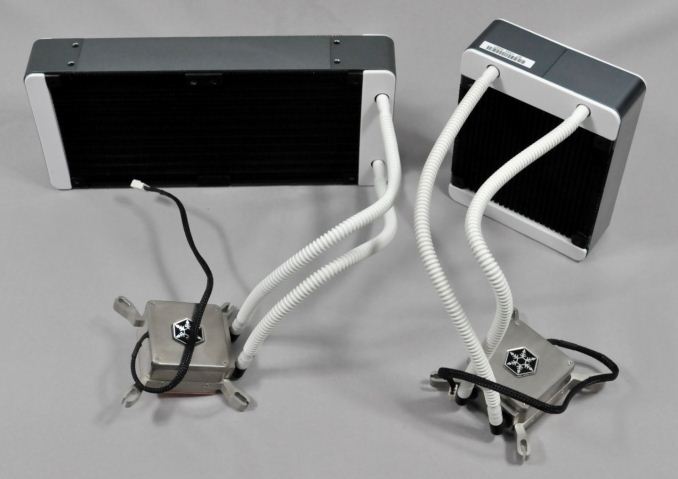Closed Loop AIO Liquid Coolers: 14-way Mega Roundup Review
by E. Fylladitakis on February 12, 2014 7:00 AM ESTEnermax
The two AIO coolers from Enermax that we had the chance to look at share a similarly sized, 120mm x 120mm radiator, yet they are absolutely nothing alike. The Liqmax 120S is a product designed with value in mind, to compete with AIO coolers in the league of the Cooler Master Seidon 120V and the Corsair H75. Its thermal performance is unimpressive, slightly worse than that of the Seidon 120V, yet the noise levels of the Liqmax 120S are considerably lower. It is unable to compete with the dual-fan H75 though, at least not while maintaining similar noise levels.
The Liqtech 120X on the other hand is very impressive, especially in terms of quality and aesthetics. A simple inspection reveals that the radiator and block of the Liqtech 120X are much better made than those of most other kits. It delivers good thermal performance while maintaining very low noise levels, considering the size of its radiator and the use of 120mm fans. The downside is that the Liqtech 120X owes much of its good performance on the extra-thick radiator, which could lead to compatibility problems with some cases if there is not enough clearance.
The only great problem that all AIO coolers from Enermax have is the low availability, as they currently are not available in North America at all and few retailers stock them in Europe. They can be imported to the US from Asia or Europe but that is a financially unrealistic option.
NZXT
NZXT currently offers only two high performance AIO coolers, both with 140mm wide radiators, which limits their compatibility significantly. On the other hand, they are the only coolers with extended (≈ 40cm) tubing, allowing the radiator to reach the front panel of a tower case. Still, the number of cases currently capable of supporting a 140mm wide radiator is quite limited.
Both the Kraken X40 and the Kraken X60 performed well in our tests, offering thermal performance similar to other AIO coolers of the same class. Specifically, they offer lower thermal performance than Cooler Master's 140mm wide coolers but maintain reasonable noise levels, while they display about the same thermal performance as Corsair's offerings but are not as quiet. While better fans could have been selected, NZXT has a tremendous advantage over the competition; the Kraken X40 and Kraken X60 retail for about the same price as other 140mm wide AIO coolers but only NZXT's offerings feature a USB interface. The USB interface allows the user to monitor and fine-tune the performance/noise ratio of the cooling system directly from the desktop, as well as to program custom LED lighting colors and effects.
Silverstone
Silverstone currently offers only two AIO liquid coolers, the Tundra TD02 and the Tundra TD03, both of which we have tested in this review. They are both based on the same design, with their only difference being the size of the radiator. Although the design of the Tundra TD03 is similar to that of the Enermax Liqtech 120X, the aesthetic design of Silverstone's offerings is quite different, going with a white/grey/nickel color theme instead of Enermax's black/red. The OEM behind them might be the same, although that is a mere guess on our part, as the fin design and frame of the radiators are significantly different.
The appearance, feel and quality of the Tundra TD02 and Tundra 03 are outstanding, greatly superior to that of most other kits. On the other hand, the overall performance of these kits actually disappointed us. It is by no means bad, as both of Silverstone's AIO coolers deliver thermal performance comparable to that of other similarly sized kits at reasonable noise levels and are especially efficient under low fan speeds. However, we expected a lot more from kits with radiators this thick and with such a classy appearance.
The mediocre performance may be due to the narrow corrugated tubing, a weak pump, a wrong choice of fans, or any combination of the above, but the fact is that a performance upgrade is required in order to overtake the competition. Furthermore, we are unsure about the white/grey color theme, as it will most likely stand out way too much inside all-black cases and that is not always the desired effect. Still, the balance between quality, performance, and value is very good and Silverstone's AIO coolers will become a favorite among those who want to combine low-noise operation and good looks. Just make sure that the 45mm thick radiators will fit inside your system before purchasing one!













139 Comments
View All Comments
thewhat - Wednesday, February 12, 2014 - link
"the Corsair H90 ... is entirely silent when its fan's voltage is reduced down to 7 Volts."I've tried some of the quietest fans in existence and at 920 rpm they weren't even quiet, let alone entirely silent.
Anything over 600-700 rpm is usually audible, but quiet. And at around 800 rpm it stops being quiet.
Maybe we just have different standards for quietness.
But then liquid cooling was never a good option for silence freaks, anyway.
E.Fyll - Wednesday, February 12, 2014 - link
There are great differences between fans, even at same RPM, depending on their engine and wing design. This is also being displayed in this review, as fans running at nearly the same RPM have vast performance differences. At one meter away, I could not possibly discern any noise coming from the H90, that is why I classified it as silent. If however you were to install it inside a metallic case with many openings, which would reflect and enhance the noise level, you might be able to notice a low-tone humming noise - that's a maybe, a mere assumption on my part.Aikouka - Wednesday, February 12, 2014 - link
I don't know if anyone else considers it to be worthwhile, but I wouldn't mind seeing how well these coolers work when you remove one of the commonly-changed variables: the fans. I rarely ever use stock fans, and along those lines, it would be interesting to see what would happen if the same fans (per standard size -- 120mm and 140mm) were used on each cooler.jjj - Wednesday, February 12, 2014 - link
Pretty pointless without a comparison with the same fans and some air coolers.silenceisgolden - Wednesday, February 12, 2014 - link
I'm a little disappointed that patent trolls kept the Swiftech offerings from this list, but that's how things are I guess.casteve - Wednesday, February 12, 2014 - link
Thanks for the review. What was the ambient noise level and the noise meter used for the test?E.Fyll - Wednesday, February 12, 2014 - link
My apologies, I should have added this into the review. Will do so from now on. The meter is an Extech HD600 and the background noise level is 30.4 dB(A) (+/- about 0.5 dB(A), depending on the night I perform a test).casteve - Wednesday, February 12, 2014 - link
Thanks. As this meter has a lower limit of 30dB(A) and an accuracy of +/-1.4dB, your ambient is probably quieter and you are just seeing the low end of what the meter can do. Sort of expected unless (as you say) you have an expensive set up for the test equipment. Get Anand to shill out the $'s for a 10dBA microphone and an anechoic chamber for that spare bedroom. :)Some terms - if the meter is reading sound pressure level, then it's dB(A) SPL, which is referenced to 20 micro Pascals (0 dB). So, 0 dB(A) SPL is the threshold of hearing, 20-30dB(A) SPL is a calm room.
pcfxer - Wednesday, February 12, 2014 - link
All of these are way too loud. At 30+ dB, none of these coolers hit the envelope for someone who actually cares about "silence" and noise.E.Fyll - Wednesday, February 12, 2014 - link
You are confusing dB and dB(A), I am afraid. The background noise of my room at 2:00AM is 30.4 dB(A). Sub-35 dB(A) levels are generally impossible to notice by a human ear. Sub-30 dB(A) levels are next to impossible to record with anything less than science lab-grade equipment. There is no handheld or desktop dB(A) meter that can perform such readings. If you have seen reviews stating sub-30 dB(A) levels, make sure to check their methodology (given that there is any). Either the meter cannot read lower than 30 dB(A) (and/or will display a bogus reading, as most cheap Chinese meters do) and the review is a fictional text or their methodology is based on dB readings, not dB(A) readings, which is useless to a consumer.